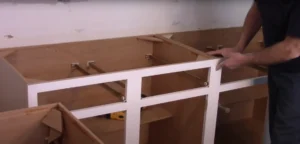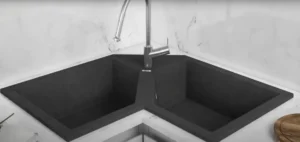Planning a kitchen remodel can be exciting, but many homeowners worry about managing costs and staying within their budget. Without a clear plan, expenses can quickly add up, making the project more stressful than it needs to be.
Did you know that the average cost of an upscale kitchen remodel exceeds $80,000? Understanding how to create a basic budget for a kitchen remodel is essential to keep your renovation on track.
This guide provides simple tips and guidelines to help you plan your kitchen renovation without overspending. Let’s get started.
Key Takeaways
- Set a Clear Budget: Decide the maximum you can spend. For a home valued at $250,000, budget between $37,500 and $50,000.
- Include a Contingency Fund: Reserve 20% of your budget for surprises. For a $70,000 remodel, add $14,000 extra.
- Allocate Funds Wisely: Split your budget into materials, labor, and design. Cabinets can take up about 30%.
- Choose Affordable Materials: Use laminate countertops and LVP flooring to save money. Laminate costs less than quartz.
- Do Some Work Yourself: Paint or install fixtures yourself to reduce labor costs and stay within budget.
Establish Your Total Budget
Set a clear limit on how much you can spend on your kitchen remodel. Also, save extra money for any surprises that might come up during the project.
Decide the maximum amount you can spend
Decide the maximum amount you can spend by first reviewing your finances. For example, Holly Honeycutt remodeled her kitchen in 2006 for $10,000. Remodeling Magazine’s Cost vs. Value report helps estimate the cost of a kitchen remodel.
A major kitchen remodel in Des Moines can exceed $100,000. If your home is valued at $250,000, set your budget between $37,500 and $50,000. Creating a realistic budget ensures you stay on track and achieve your dream kitchen.
Setting a clear budget is the first step to a successful kitchen remodel.
Set aside a contingency fund for unexpected costs
Set aside 20 percent of your kitchen remodel budget for unexpected costs. For example, if your remodel costs $70,000, add $14,000 as a contingency fund. This extra money helps cover surprises like plumbing issues or price increases.
Some experts suggest adding up to 30 percent to your base budget, making the total $91,000 for a $70,000 remodel. A contingency fund ensures you stay on budget even when unexpected expenses arise.
Including a contingency fund gives you flexibility during your renovation. It helps you manage costs without stress. Next, learn how to plan your kitchen remodel effectively.
How to Plan Your Kitchen Remodel
Create a detailed plan for your kitchen remodel by taking accurate measurements of your space. Sketch a new kitchen layout that meets your needs and fits your budget. Include all parts of the kitchen remodel, such as cabinets, countertops, and appliances.
Holly Honeycutt remodeled her kitchen in 2006 for $10,000 by focusing on essential elements and managing her expenses carefully. Assess your kitchen design to ensure it aligns with your renovation goals and available funds.
Evaluate your financial capability to pay for a kitchen remodel and allocate funds accordingly. Prioritize the areas that matter most, like flooring or lighting, based on your budget for your kitchen.
Consider the square footage and how each part of the kitchen remodel will impact the overall renovation cost. A well-planned kitchen layout helps keep kitchen remodel costs under control and ensures a smooth remodeling project.
Next, break down the costs to manage your budget effectively.
Break Down the Costs
Allocate your budget for key areas like kitchen cabinets, appliances, and labor costs. Focus your spending on the features that are most important to your renovation goals.
Apportion budget for materials, labor, and design
Divide your remodeling budget into three main parts: materials, labor, and design. Cabinets usually take up about 30% of your renovation budget. Choose budget kitchen options to save money.
For countertops, high-end quartz like Caesarstone starts at $90 per square foot. Flooring choices vary from LVP or tile at $10 per square foot to hardwood or engineered wood at $18 per square foot.
Professional installation of hardwood can cost over $20 per square foot.
Labor costs also need careful planning. Hiring a professional ensures quality work but can increase your overall budget. For design, prioritize what matters most to your kitchen renovation budget.
A lower-end faucet costs around $500, while luxury faucets can exceed $3,000. Lighting fixtures, such as a pendant, are about $600 each. By breaking down your budget this way, you can manage costs effectively and achieve your desired kitchen remodel.
Prioritize spending based on your renovation goals
After allocating funds for materials, labor, and design, it’s essential to prioritize spending based on your renovation goals. Define specific objectives for your kitchen remodel to ensure your budget addresses what matters most.
For example, if cabinetry is a priority, consider budget-friendly options like IKEA cabinets, which offer lower prices compared to semi-custom or custom cabinets. Choose countertop materials that balance aesthetics and cost, such as quartz or butcher block, and send your plans to fabricators for accurate quotes.
Allocate funds wisely for hardware, keeping in mind that prices can range from $15 to $45 per item. Focusing on features that provide both practical and visual value helps create a functional and beautiful kitchen without overspending.
Cost-Saving Tips
Choose affordable materials like laminate countertops to cut costs without sacrificing style. Take on tasks such as painting or installing fixtures yourself to reduce labor expenses and stay within your budget.
Choose less expensive materials where possible
Using laminate is a smart way to save money on a kitchen remodel. Laminate and composite materials cost less than quartzite or marble. For example, laminate countertops can lower your total cost.
Choose LVP or tile flooring starting at $10 per square foot instead of hardwood or engineered wood. Basic subway tiles for your backsplash cost $8-$9 per square foot, much cheaper than marble mosaics.
These choices help you stay within your budget and create a beautiful kitchen.
Consider doing some work yourself to save on labor costs
Doing some work yourself can lower your kitchen remodel budget. Remove old cabinets and appliances before contractors arrive. This saves on labor costs and speeds up the renovation.
Painting walls or frames on your own is another great way to cut expenses. Basic painting tasks are easy and don’t require professional help.
Maintaining the same kitchen layout also keeps costs down. You won’t need to pay for redesigning or new plumbing. Choose less expensive materials when possible. For example, a lower-end faucet costs around $500, while luxury options can exceed $3,000.
Doing these tasks yourself helps you stay within your budget and makes your remodel more affordable.
How to Remodel Your Kitchen on a Budget
Remodeling your kitchen does not have to break the bank. Use these tips to stay within your budget for your kitchen remodel.
- Set a Minimum Budget: Allocate at least $14,000 for a budget-friendly kitchen project to cover essential updates.
- Plan Your Project Carefully: Decide which parts of the kitchen to remodel, such as installing a new dishwasher or changing kitchen flooring.
- Do It Yourself: Save on labor costs by handling tasks like interior painting, installing a tile backsplash, or replacing outlets and lights. Ensure you have the necessary skills and permits for safety.
- Choose Cost-Effective Materials: Select less expensive materials for countertops and cabinets to reduce overall costs.
- Prioritize Spending: Focus your budget on areas that add the most value, like new appliances or better lighting.
- Use a Spreadsheet: Track all expenses using a spreadsheet to ensure you don’t exceed your budget breakdown.
- Set Aside a Contingency Fund: Reserve funds for unexpected costs, such as demolition or additional plumbing needs.
- Consider Financing Options: Use home equity or a low-interest loan to finance your kitchen remodel without high unsecured debt.
Full Kitchen Remodel Considerations
A full kitchen remodel can transform your space, but costs have risen by 20-30% in the last few years. Material and labor shortages drive these increases. High-end quartz like Caesarstone starts at $90 per square foot.
Countertop prices are up 15% this year. Cabinet prices vary too. IKEA cabinets are affordable, while custom ones cost more. Knowing how much you’re willing to spend helps in planning your kitchen remodel.
Divide your budget into materials, labor, and design. Set aside funds for unexpected costs. Prioritize your kitchen needs, such as a new refrigerator or better storage. Sending plans to countertop fabricators can give accurate pricing.
This helps you create a budget that covers all parts of a kitchen remodel. Choose less expensive materials and do some work yourself to control the cost of remodeling. Working with a contractor ensures your remodeled kitchen meets your goals.
Essential Cost-Saving Tips for Your Kitchen Remodel Budget
Creating a budget is a vital step in your kitchen remodel. Plan carefully and keep track of your expenses to stay on track. Use these tips to manage costs and make smart choices. Stay organized and prioritize what matters most.
Your dream kitchen is within reach.
FAQs
1. How much money do I need to remodel a kitchen?
The cost to remodel a kitchen can vary. It depends on the size and what parts of a kitchen remodel you choose. On average, a basic remodel can cost anywhere from $10,000 to $30,000. Knowing how much money you need helps you plan your budget and ensure you have enough cash or financing.
2. What should I include in a basic kitchen remodel budget?
A basic kitchen remodel budget should include costs for materials, labor, and any fees. Break down your budget by divvying up funds for cabinets, countertops, appliances, and lighting. Don’t forget to budget for additional costs like permits and unexpected expenses to keep wiggle room in your budget.
3. How can a home equity line of credit help fund a kitchen remodel?
A home equity line of credit (HELOC) allows you to borrow against the equity in your home. This can be a good option for funding a kitchen remodel. HELOCs often have lower interest rates than credit cards. However, your home serves as collateral, so it’s important to understand the terms to avoid default.
4. What is the cost of labor in a kitchen remodel?
Labor costs can make up a significant part of your kitchen remodel. Depending on the size and complexity, expect to pay between 20% to 35% of your total budget for labor. Hiring skilled professionals ensures quality work but remember to compare quotes to get a great price without overpaying.
5. Can I get a tax deduction for kitchen remodeling?
Some kitchen remodel expenses might qualify for a tax deduction. If the remodel improves energy efficiency, you may be eligible for certain credits. Check with a tax professional to see which parts of your kitchen and bath remodel can provide a tax deduction and maximize your investment.
6. How do I divvy up my budget for a kitchen remodel?
To divvy up your budget, start by listing all parts of a kitchen remodel. Allocate funds based on priority and cost per item. For example, spend more on cabinets and countertops, and less on accessories. This approach helps you manage costs effectively and ensures the most important elements are covered.





